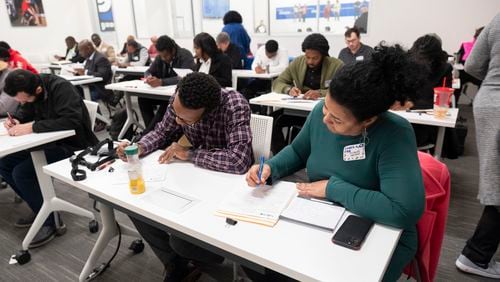In continued defiance of last year’s many predictions of recession, metro Atlanta added 11,200 jobs in March, the Georgia Department of Labor said Thursday.
Despite losses in December and January, much of it in post-holiday cuts to logistics, and delays in film productions that cost some jobs, the region has added 31,100 jobs in the past year with expansion in health care, hospitality and local government.
Interest remains high, inflation hasn’t disappeared, but consumer spending has been solid and many companies have decided that a downturn is not imminent, said Amy Mangan, Atlanta market director for staffing company Robert Half. “In general, we saw a lot of companies put positions on hold last year and we see a lot of that loosening up.”
And while hiring has been healthy, layoffs are muted: Filings for unemployment benefits were 15% lower in March than they were a year ago, according to the Department of Labor.
Metro Atlanta accounts for 62.1% of the state’s jobs, a share that is slightly smaller than a year ago, but much higher than when the government started keeping track in 1990. Back then, Atlanta represented 53.4% of Georgia’s jobs.
During March, hiring was especially strong in hospitality, corporate jobs and health care, said Bruce Thompson, the state’s commissioner of labor. “This continuous growth is a strong indicator that our economic momentum is not slowing down.”
Looking ahead, Atlanta ranks 24th for expected growth among the top 50 metros, according to an analysis by Fifth Third Bank.
The metro Atlanta unemployment rate, which tracks only people actively looking for work, did tick up from 3.0% in February to a still-low 3.1%, according to the Department of Labor.
But the rate can rise even when hiring is strong if people are entering the job-search faster than they are being snapped up. And the Atlanta labor force swelled in March by 25,295 — the largest one-month increase since May 2020 when workers were rushing back into the workforce after the pandemic shutdowns.
Over the past year, job growth has been slower than the two previous years, but the market for workers — especially in blue-collar and other relatively low-income positions — remains tight for many employers.
“I speak to a lot of business groups and when you ask ‘are you having trouble finding people to hire?’ they all raise their hands,” said Keith Parker, chief executive of Goodwill of North Georgia, which trains and places workers. “Then, I ask, ‘have you expanded where you are looking?’”
Tight labor markets often compel companies into higher pay to lure and retain employees. The median raise is now 4.7%, according to the Atlanta Federal Reserve Bank, although that’s lower than two years ago.
Tight job markets also tend to be good for people who are typically not at the front of the line for many employers: people who have been incarcerated, people with disabilities, racial minorities and immigrants.
The national jobless rate for Blacks in March was 6.4%, about half of its level a decade ago, according to the Bureau of Labor Statistics. The unemployment rate for people with disabilities was 8.2%, compared to 14.5% in 2014.
Timely data is hard to come by for formerly incarcerated people, but estimates are more than half are without jobs.
“If they have a job within three days of getting out, the chance of their going back (to prison) dramatically changes,” Parker said. “So we work with dozens of employers to get them to be open to interviewing and hiring them.”
That hiring is a plus for the employer, the worker and the economy, as well, he said.
Goodwill last year trained and placed 22,113 workers at area companies, including with Goodwill, most frequently in warehousing, retail, hospitality and manufacturing, he said.
Among examples of success that Goodwill boasts is Darnell Champion, 73, who, after incarceration and repeated arrests, was given “one last chance” several decades ago. He has been with Goodwill since.
“I was a custodian,” he said. “Now I’m a supervisor.”
Champion runs a 16-person Goodwill crew contracted to clean at the U.S. Centers for Disease Control and Prevention. He serves as an example to several others on the crew who have been in prison, he said. “When I do better, they do better.”
Metro Atlanta job change, March
Best, pre-pandemic: 31,300 (2014)
Worst, pre-pandemic: -9,600 (2009)
Average, pre-pandemic: 13,400
Recent: 11,200 (2024)
Metro Atlanta unemployment rate, March
Best, pre-pandemic: 3.1% (1999, 2000)
Best, overall: 2.8% (Dec., 2022)
Worst, pre-pandemic: 10.8% (2010)
Worst, overall: 12.3% (March 2020)
Average, pre-pandemic: 5.5%
Recent: 3.1% (2024)
March growth in Metro Atlanta labor force
Best: 26,187 (2016)
Worst: -7,384 (2010)
Recent: 25,295 (2024)
Average pre-pandemic: 6,756
March growth in Metro Atlanta labor force, year to year
Best: 6.5% (2019)
Worst: -2.1 (2009)
Average: 2.1%
Recent: 1.6% (2024)
Metro Atlanta’s share of Georgia jobs
High: 63.4% (July 2023)
Low: 53.3% (May 1990)
Recent: 62.1% (March 2024)
Cities of the South
Pace of metro growth, past 12 months
Atlanta: 1.1%
Birmingham: 1.3%
Charlotte: 1.6%
Dallas: 1.8%
Miami: 2.6%
Nashville: 0.8%
Orlando: 2.1%
Tampa: 1.7%
United States: 1.9%
Sources: Georgia Department of Labor, Bureau of Labor Statistics







